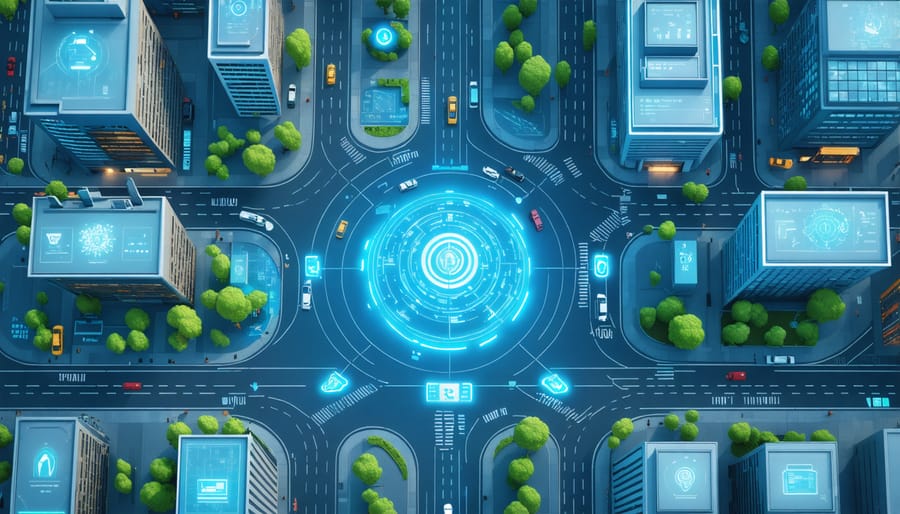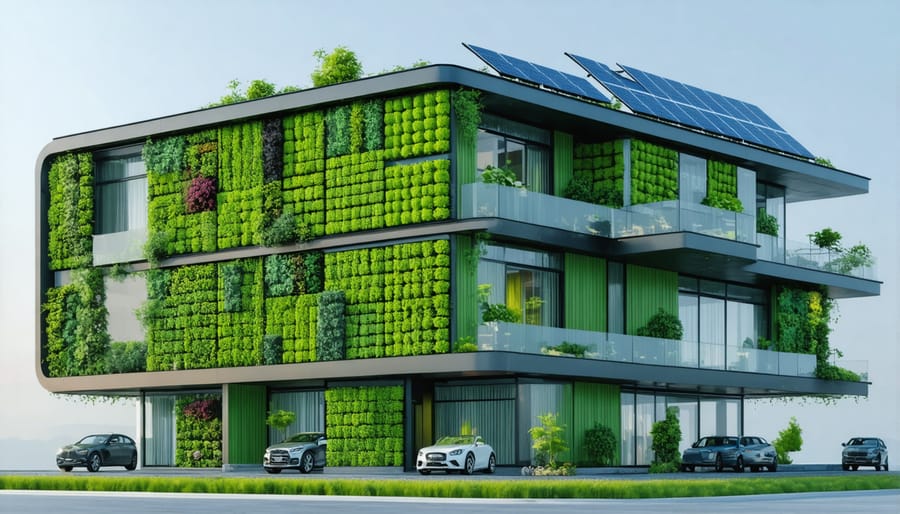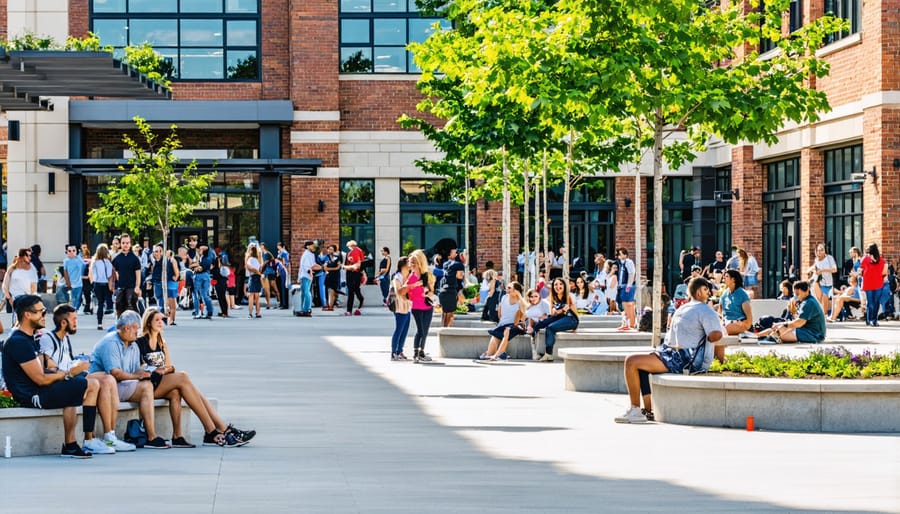Urban renewal stands at the forefront of modern city transformation, driving economic growth and reshaping communities through strategic redevelopment initiatives. As metropolitan areas face unprecedented challenges from aging infrastructure, population density pressures, and sustainability demands, comprehensive urban renewal plans have emerged as critical tools for revitalizing declining neighborhoods and creating resilient city spaces.
Recent data indicates that successful urban renewal projects increase property values by an average of 30% while generating significant improvements in public safety, environmental sustainability, and community engagement. These initiatives now incorporate smart city technologies, green infrastructure, and inclusive design principles to create multifaceted solutions that address both immediate needs and long-term urban sustainability goals.
The evolution of urban renewal strategies has moved beyond simple structural improvements to encompass holistic approaches that consider social equity, economic vitality, and environmental stewardship. Leading cities worldwide are implementing data-driven planning methods and innovative financing models to ensure renewal projects deliver measurable benefits to all stakeholders while preserving community character and promoting sustainable development practices.
This transformation in urban renewal methodology represents a paradigm shift in how cities approach redevelopment, emphasizing collaborative planning processes and integrated solutions that balance progress with preservation. Understanding these modern approaches is essential for professionals tasked with shaping the future of urban spaces.

Smart Technology Integration in Urban Renewal
IoT and Data-Driven Planning
The integration of Internet of Things (IoT) technology and data analytics has revolutionized urban renewal planning, enabling more precise and responsive development strategies. Smart sensors deployed throughout cities collect real-time data on traffic patterns, pedestrian flow, air quality, and infrastructure performance, providing planners with unprecedented insights for decision-making.
These sensor networks, combined with advanced analytics platforms, help identify areas requiring immediate intervention and predict future development needs. For instance, footfall sensors in public spaces can reveal underutilized areas that may benefit from redesign, while environmental monitors track pollution levels to inform green space planning.
Data-driven planning also enhances resource allocation efficiency. By analyzing patterns in utility usage, maintenance requirements, and public service demands, planners can optimize infrastructure investments and reduce operational costs. Cities like Barcelona and Singapore have successfully implemented IoT networks that monitor everything from waste management to street lighting, resulting in significant operational improvements and cost savings.
Furthermore, real-time data visualization tools enable stakeholders to make informed decisions quickly and adjust plans based on changing urban dynamics. This adaptive approach ensures that renewal projects remain responsive to community needs while maximizing the return on investment for development initiatives.
Smart Infrastructure Solutions
Modern urban renewal projects increasingly rely on smart infrastructure solutions to enhance city operations and improve quality of life. These intelligent systems integrate IoT sensors, advanced analytics, and automated controls to optimize public utilities and services across multiple domains.
Key implementations include smart grid technology for efficient power distribution, intelligent water management systems that detect leaks and monitor quality in real-time, and adaptive traffic control systems that respond to changing traffic patterns. These solutions utilize cloud computing and AI algorithms to process vast amounts of data, enabling predictive maintenance and proactive resource allocation.
Municipalities are particularly focusing on integrated command centers that consolidate data streams from various infrastructure components. These centers enable real-time monitoring and coordinated responses to urban challenges, from traffic congestion to emergency situations. Advanced metering infrastructure (AMI) systems are being deployed to optimize utility consumption and billing accuracy, while smart lighting systems adjust illumination based on actual usage patterns and environmental conditions.
The integration of these technologies requires careful consideration of cybersecurity protocols and standardization of communication interfaces to ensure seamless operation and protection of critical infrastructure components.
Sustainable Development Practices
Green Building Standards
Green building standards form a critical cornerstone of modern urban renewal initiatives, emphasizing sustainability and environmental responsibility in construction practices. Leading certification systems like LEED, BREEAM, and WELL Building Standard provide comprehensive frameworks for implementing sustainable design and construction methods. These standards typically mandate the use of eco-friendly materials, energy-efficient systems, and waste reduction strategies throughout the construction process.
Key implementation requirements include utilizing recycled and locally-sourced materials, installing high-efficiency HVAC systems, implementing water conservation measures, and incorporating renewable energy solutions. Building envelope designs must meet stringent thermal performance criteria, while indoor environmental quality standards ensure optimal air quality and natural lighting for occupants.
Construction teams must document material sourcing, track waste management, and monitor energy performance throughout the building process. Advanced building management systems enable real-time monitoring of resource consumption and environmental impacts. According to industry data, green buildings typically achieve 30-50% energy savings compared to conventional structures while reducing water consumption by 30-40%.
Project managers must ensure compliance with these standards through regular audits and certification milestones, maintaining detailed documentation throughout the construction phase. This systematic approach to sustainable construction contributes significantly to the overall environmental performance and long-term viability of urban renewal projects. For more details on certifications, read about top certifications available for green building.

Energy Efficiency Measures
Modern urban renewal projects prioritize energy efficiency through comprehensive strategies that combine innovative technologies with sustainable design principles. Building retrofits incorporate smart building management systems (BMS) that optimize HVAC operations, lighting controls, and power distribution. These systems typically reduce energy consumption by 20-35% compared to conventional buildings.
Solar integration plays a crucial role, with rooftop installations and building-integrated photovoltaics (BIPV) becoming standard features in renewal projects. Combined with energy storage solutions, these systems provide reliable renewable power while reducing grid dependency. Advanced building envelope technologies, including high-performance windows and smart façade systems, minimize heat transfer and optimize natural lighting.
District heating and cooling networks are increasingly integrated into large-scale renewal projects, enabling efficient energy distribution across multiple buildings. These systems typically achieve 30-40% higher efficiency compared to individual building solutions. Implementation of LED lighting systems, coupled with motion sensors and daylight harvesting, further reduces energy consumption.
Energy monitoring and analytics platforms provide real-time consumption data, enabling facility managers to identify optimization opportunities and maintain peak system performance. Successful projects often incorporate green certification standards like LEED or BREEAM, ensuring comprehensive implementation of energy-efficient measures throughout the development lifecycle.
Community-Centric Design

Public Space Optimization
Public spaces serve as the cornerstone of successful urban renewal initiatives, requiring careful optimization to maximize their social and economic benefits. Modern approaches focus on creating multi-functional spaces that accommodate diverse community needs while ensuring universal accessibility. Studies indicate that well-designed public spaces can increase property values by up to 20% and significantly enhance community engagement.
Key optimization strategies include implementing flexible design elements that adapt to different uses throughout the day, incorporating sustainable landscaping that reduces maintenance costs, and integrating smart technologies for improved safety and user experience. Recent developments in urban design prioritize the creation of pocket parks, pedestrian plazas, and community gathering areas that serve as micro-centers for social interaction.
Successful public space optimization requires careful consideration of factors such as sight lines, pedestrian flow patterns, and barrier-free access points. Urban planners increasingly employ data-driven approaches to analyze foot traffic patterns and user behavior, ensuring that space allocation meets actual community needs. This evidence-based methodology has proven particularly effective in high-density urban areas where space utilization must be maximized.
Leading cities worldwide demonstrate that well-optimized public spaces contribute significantly to urban vitality, supporting both social cohesion and economic development while fostering a stronger sense of community identity.
Social Infrastructure Development
Social infrastructure development forms the backbone of successful urban renewal initiatives, integrating essential community facilities and services to create sustainable, livable environments. This comprehensive approach encompasses healthcare facilities, educational institutions, recreational spaces, and cultural centers strategically positioned to serve diverse community needs.
Modern urban renewal projects prioritize the creation of multi-purpose community hubs that combine various services under one roof, optimizing land use while improving accessibility. These facilities often feature flexible designs that can adapt to changing demographic needs and social patterns over time.
Key considerations include the strategic placement of facilities to ensure equitable access across neighborhoods, integration with existing public transportation networks, and implementation of smart city technologies for improved service delivery. Successful projects typically incorporate public spaces that foster community interaction and social cohesion.
Case studies from cities like Copenhagen and Singapore demonstrate how well-planned social infrastructure can significantly enhance quality of life and community resilience. These examples show that investing in community facilities during the early stages of urban renewal yields long-term social and economic benefits, including increased property values and reduced social isolation.
Economic Revitalization Strategies
Public-Private Partnerships
Modern urban renewal initiatives increasingly rely on public-private partnerships as a cornerstone of successful development. These collaborative funding models combine government resources with private sector expertise and capital, creating more sustainable and financially viable projects. Typically, the public sector contributes through tax incentives, land acquisition, and regulatory support, while private entities bring market knowledge, operational efficiency, and additional funding sources.
Recent successful implementations have demonstrated that these partnerships can accelerate project timelines by 30-40% compared to traditional public sector development approaches. The risk-sharing structure inherent in these arrangements helps protect both parties while ensuring project delivery meets community needs. Private sector partners often introduce innovative construction methods and sustainable design practices, while public oversight maintains accountability and alignment with broader urban planning objectives.
Key to success is establishing clear governance frameworks, transparent financial arrangements, and detailed performance metrics at the outset. This approach has proven particularly effective in large-scale mixed-use developments and infrastructure projects where public benefit and commercial viability must be carefully balanced.
Local Business Integration
Successful urban renewal initiatives prioritize the preservation and enhancement of existing local businesses, recognizing them as vital components of community identity and economic sustainability. Integration strategies typically involve creating specialized development zones that protect established enterprises while facilitating modernization efforts. Project managers should conduct comprehensive business impact assessments during the planning phase to identify potential disruptions and develop mitigation strategies.
Key integration measures include providing temporary relocation assistance, offering tax incentives for businesses that remain in the renewal zone, and implementing phased construction schedules that minimize operational disruptions. Construction professionals often collaborate with business improvement districts (BIDs) to ensure renovation work maintains customer access and visibility throughout the project lifecycle.
Recent case studies demonstrate that successful integration often requires flexible design solutions, such as incorporating mixed-use spaces that combine retail with residential developments. Programs like facade improvement grants and infrastructure upgrades can help existing businesses modernize while maintaining their authentic character. Progressive urban renewal projects also typically include provisions for affordable commercial space retention, ensuring small businesses can remain viable in revitalized areas.
Implementation and Project Management
Phasing and Timeline Management
Effective urban renewal projects require meticulous phase planning and timeline management to minimize disruption while maximizing efficiency. The process typically begins with a comprehensive site assessment phase lasting 2-3 months, followed by stakeholder engagement and regulatory approval phases spanning 4-6 months. The actual implementation is usually divided into three main stages: infrastructure upgrade, building rehabilitation, and public space development.
Critical path methodology (CPM) is essential for managing these complex phases, with particular attention to dependencies between different project components. For instance, utility infrastructure must be upgraded before building renovations can commence. Modern project management software enables real-time tracking and adjustment of timelines, helping teams respond quickly to unexpected challenges.
Successful projects often employ a rolling wave planning approach, where near-term activities are planned in detail while maintaining flexibility for later phases. This strategy allows for adaptation to changing community needs and market conditions. Project managers should build in contingency time of approximately 15-20% for each phase to account for weather delays, permit processing, and unforeseen site conditions. Regular milestone reviews ensure project alignment with both timeline and budget constraints while maintaining quality standards.
Stakeholder Coordination
Effective stakeholder coordination is crucial for the success of urban renewal projects, requiring a systematic approach to managing diverse interests and expectations. Project managers must establish clear communication channels between property developers, local authorities, community representatives, and business owners. Regular stakeholder meetings, progress reports, and feedback sessions help maintain transparency and address concerns proactively.
A comprehensive stakeholder management plan should include detailed documentation of roles, responsibilities, and decision-making processes. This ensures all parties understand their involvement and can contribute effectively to the project’s success. Digital collaboration platforms and project management tools facilitate real-time information sharing and streamline communication between stakeholders.
Successful urban renewal projects often employ dedicated stakeholder liaison officers who serve as primary points of contact, managing relationships and resolving conflicts before they escalate. These professionals must balance competing interests while maintaining focus on the project’s objectives and timeline, ensuring that stakeholder engagement supports rather than hinders progress.
As we look toward the future of urban renewal, several key strategies have emerged as essential components for successful project implementation. The integration of smart technology, sustainable design principles, and community-focused development approaches continues to shape the evolution of urban regeneration efforts worldwide.
Industry leaders increasingly recognize that successful urban renewal requires a balanced approach combining infrastructure modernization with social sustainability. Data-driven decision-making, powered by advanced analytics and IoT solutions, enables more precise planning and resource allocation. This technological integration, coupled with green building practices and adaptive reuse strategies, forms the foundation of modern urban renewal frameworks.
Looking ahead, the industry can expect to see greater emphasis on mixed-use developments, transit-oriented design, and climate resilience in urban renewal projects. The rise of public-private partnerships continues to provide innovative funding solutions, while stakeholder engagement platforms ensure community voices remain central to development decisions.
The future outlook for urban renewal remains promising, with emerging technologies and sustainable practices driving transformation. Success will depend on maintaining flexibility in planning approaches, embracing innovative construction methods, and prioritizing community needs. As cities continue to evolve, the focus on creating resilient, inclusive, and sustainable urban environments will become increasingly critical for project success.
Moving forward, construction professionals must stay informed about emerging trends and technologies while maintaining strong connections with local communities to ensure urban renewal projects deliver lasting positive impact.

